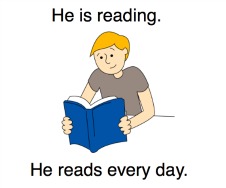How do you choose between Present Simple and Present Continuous?



Both Present Simple and Present Continuous are used to talk about something that happens in present.
We use Present Simple when we want to talk about fixed habits or routines – things that don’t change.
We use Present Continuous to talk about actions which are happening at the present moment, but will soon finish.
Compare the following examples:
- He is reading a book.
- He reads every day.
‘He reads every day’ tells us that reading a book is something the speaker always does. It is part of a routine or habit. This is a permanent situation.
‘He is reading a book’ tells us that the speaker is reading a book right now. Soon this action will be over. This is a temporary situation.
Present Simple or Present Continuous?
So, how do you choose between the Present Simple and Present Continuous?
Present Simple
1. We use Present Simple to talk about facts, hobbies and regular activities:
- Tom lives in London. (fact)
- I go swimming on Mondays. (regular activity)
- Do you speak Russian? (question about a fact)
2. We use the Present Simple to talk or ask about things that are always true:
- Do you speak English?
- I don’t have a car, I prefer to ride a bike.
3. We use the Present Simple to express likes, dislikes and opinions:
- I like football. (likes)
- I don’t like tennis. (dislikes)
- Do you love pop music? (question about likes)
- I think it’s interesting. (opinions)
4. We also use the Present Simple to talk or ask about habits:
- Peter goes for a walk every day.
- Do you drink tea or coffee in the morning?
5. We often use the Present Simple with adverbs of frequency (always, sometimes, never, etc.), or when we say a time, day or period (at 9.00, on Wednesdays, in spring, etc.):
- Sometimes I dream about you.
- I never walk alone at night.
- Jane wakes up at 7.00 a.m.
- He meets with his friends on Saturdays.
Present Continuous
1. We use the Present Continuous to talk about things happening now, or unfinished activities:
- Are you reading a book? (now)
- They are building a new house. (it’s not finished yet)
- Mary is studying French at university. (around now, not at the moment of speaking)
2. We use the Present Continuous to talk about future arrangements:
- She is getting married on November 5th.
- We’re leaving tomorrow.
3. We use the Present Continuous to talk about annoying habits (+ always):
- You are always losing things.
- The children are always fighting.
4. We use expressions like ‘at the moment’, ‘now’, and ‘today/this week/month/year’:
- Michael is talking on the phone at the moment.
- It’s snowing a lot this week.
- I’m working in our Chicago office this month.
| Note: The verbs ‘want‘, ‘like‘, ‘love‘, ‘need‘, ‘understand‘ and ‘believe‘ are not used in Present Continuous: – I want something to eat. NOT: – Do you need a pencil? NOT: |
How to form
Let’s compare the forms of Present Simple and Present Continuous:



Adverbs of time
Let’s compare the adverbs and adverbial phrases that are used with Present Simple and Present Continuous:



Watch the video from Learn English from Nick Shepherd explaining the difference between Present Simple and Present Continuous:
See also: